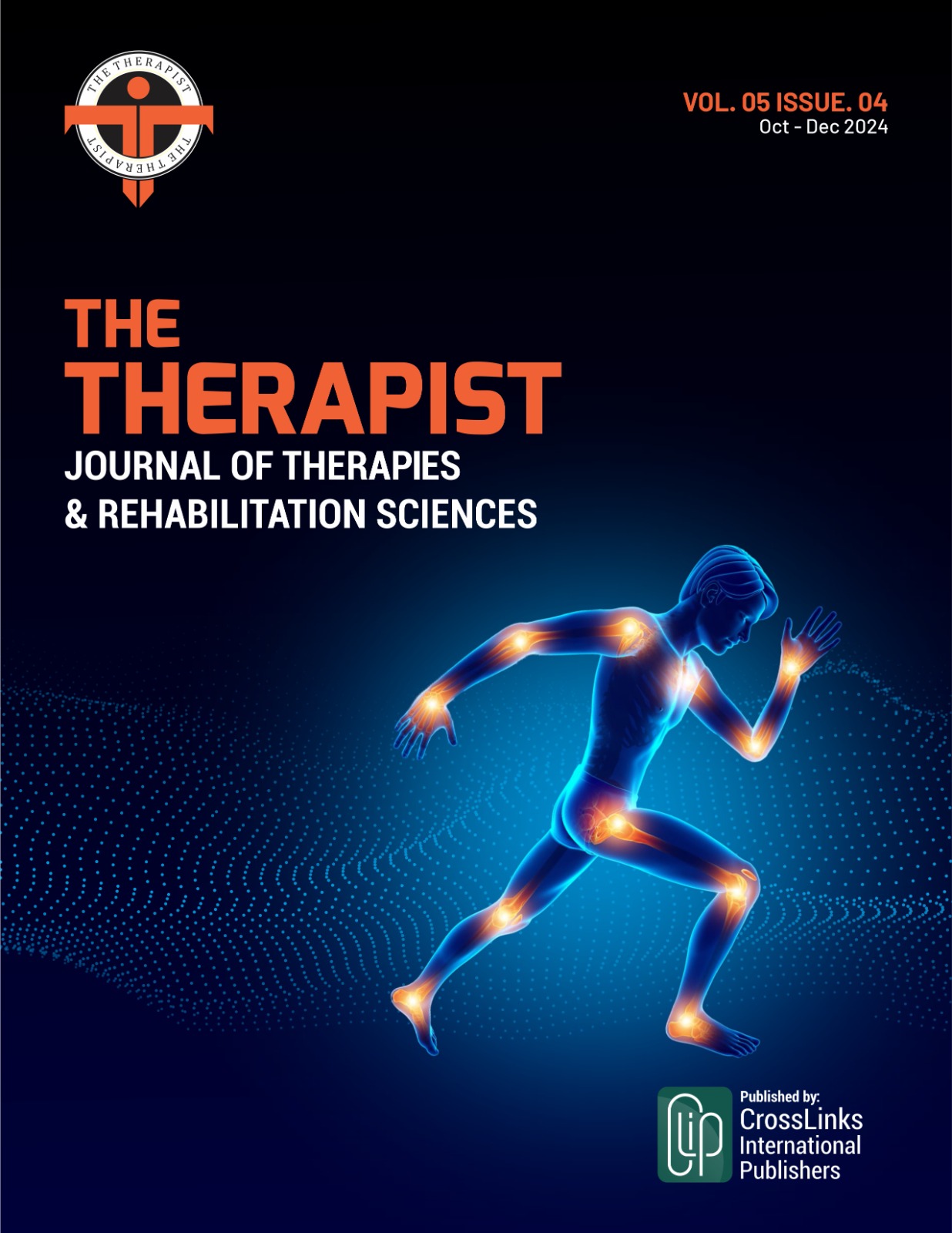Association of Low Back Pain with Sitting Patterns among Desk-Based Office Workers
Low Back Pain with Sitting Patterns among Desk-Based Office Workers
DOI:
https://doi.org/10.54393/tt.v5i04.265Keywords:
Desk-Based Office Workers, Low Back Pain, Sitting Patterns, AssociationAbstract
Low back pain (LBP) is one of the most frequently observed musculoskeletal complaints of office workers who sit at the desk for most of their working hours, chiefly as a result of sitting and poor sitting postures. Since the sedentary working conditions are on the increase, it is essential to know the connection between sitting patterns and LBP. Objective: To determine the association of LBP with sitting patterns among desk-based office workers. Methods: The cross-sectional study was conducted at the University of Lahore for four months. A sample of 72 faculty members aged 25–55 years was selected using convenience sampling. Data were collected using a self-structured questionnaire covering demographic details, sitting patterns and pain severity, which was measured using the Visual Analogue Scale (VAS), a 10-point scale where 0 indicates 'no pain' and 10 indicates 'worst possible pain'. Statistical analysis was conducted by SPSS version 25.0, and the chi-square test assessed the association between variables. Results: The results showed 91.7% of participants reported experiencing LBP in the past year. Most participants (52.8%). Seated position for more than six hours per day, and 70.8% rated their posture as average. A significant number (58.3%) only occasionally supported their back properly, and 63.9% had monitors not aligned at eye level. The association between poor sitting habits and increased LBP was statistically significant (p<0.01). Conclusions: The present study shows a close relationship between LBP and sitting habits in office workers who sit at their workstations.
References
Alaca N, Acar AÖ, Öztürk S. Low Back Pain and Sitting Time, Posture and Behavior in Office Workers: A Scoping Review. Journal of Back and Musculoskeletal Rehabilitation. 2025 Mar: 10538127251320320. doi: 10.1177/10538127251320320.
Rezwan AK, Raisa SS, Toma TA, Ahmed N, Tandra AJ, Barua D. Study on Association between Daily Office Activity and Low Back Pain among the Desk Job Workers. Journal of Pharmaceutical Negative Results. 2023: 986-92.
Kurosawa S, Shibata A, Ishii K, Koohsari MJ, Oka K. Identifying Typologies of Diurnal Patterns in Desk-Based Workers’ Sedentary Time. PLOS One. 2021 Apr; 16(4): e0248304. doi: 10.1371/journal.pone.0248304.
Sarbiah A, Maulina D, Sunsaru A, Wijaya JK. Relationship Between Sitting Position and Sitting Duration with Low Back Pain Complaints in Back Office. Journal La Medihealtico. 2024 Aug; 5(3): 671-80. doi: 10.37899/journallamedihealtico.v5i3.1422.
Malik KM, Nelson AM, Chiang TH, Imani F, Khademi SH. The Specifics of Non-Specific Low Back Pain: Re-Evaluating the Current Paradigm to Improve Patient Outcomes. Anesthesiology and Pain Medicine. 2022 Nov; 12(4): e131499. doi: 10.5812/aapm-131499.
Krismer M and Van Tulder M. Low Back Pain (Non-Specific). Best Practice and Research Clinical Rheumatology. 2007 Feb; 21(1): 77-91. doi: 10.1016/j.berh.2006.08.004.
Pate JW, Joslin R, Hurtubise K, Anderson DB. Assessing a Child or Adolescent with Low Back Pain Is Different to Assessing an Adult with Low Back Pain. Journal of Pediatrics and Child Health. 2022 Apr; 58(4): 566-71. doi: 10.1111/jpc.15933.
Makkiyah FA, Sinaga TA, Khairunnisa N. A Study from A Highly Populated Country: Risk Factors Associated with Lower Back Pain in Middle-Aged Adults. Journal of Korean Neurosurgical Society. 2023 Mar; 66(2): 190-8. doi: 10.3340/jkns.2021.0278.
Hoy D, Brooks P, Blyth F, Buchbinder R. The Epidemiology of Low Back Pain. Best Practice and Research Clinical Rheumatology. 2010 Dec; 24(6): 769-81. doi: 10.1016/j.berh.2010.10.002.
Nguyen P, Ananthapavan J, Gao L, Dunstan DW, Moodie M. Cost-Effectiveness Analysis of Sedentary Behaviour Interventions in Offices to Reduce Sitting Time in Australian Desk-Based Workers: A Modelling Study. PLOS One. 2023 Jun; 18(6): e0287710. doi: 10.1371/journal.pone.0287710.
Ryan CG, Dall PM, Granat MH, Grant PM. Sitting Patterns at Work: Objective Measurement of Adherence to Current Recommendations. Ergonomics. 2011 Jun; 54(6): 531-8. doi: 10.1080/00140139.2011.570458.
Chaiklieng S, Suggaravetsiri P, Stewart J. Incidence and Risk Factors Associated with Lower Back Pain among University Office Workers. International Journal of Occupational Safety and Ergonomics. 2021 Oct; 27(4): 1215-21. doi: 10.1080/10803548.2019.1706827.
Intan YR, Wulandari RA, Yuniar P. Prevalence of Low Back Pain Among Office Workers During the COVID-19 Pandemic in Various Countries: A Systematic Review. Kesmas. 2025 Feb; 20(1): 24-31. doi: 10.7454/kesmas.v20i1.1391.
Minoura A, Ishimaru T, Kokaze A, Tabuchi T. Increased Work from Home and Low Back Pain among Japanese Desk Workers During the Coronavirus Disease 2019 Pandemic: A Cross-Sectional Study. International Journal of Environmental Research and Public Health. 2021 Nov; 18(23): 12363. doi: 10.3390/ijerph182312363.
Biyani A and Andersson GB. Low Back Pain: Pathophysiology and Management. Journal of the American Academy of Orthopedic Surgeons. 2004 Mar; 12(2): 106-15. doi: 10.5435/00124635-200403000-00006.
Stephenson A, McDonough SM, Murphy MH, Nugent CD, Wilson IM, Mair JL. Exploring the Views of Desk-Based Office Workers and Their Employers’ Beliefs Regarding Strategies to Reduce Occupational Sitting Time, with an Emphasis on Technology-Supported Approaches. Journal of Occupational and Environmental Medicine. 2020 Feb; 62(2): 149-55. doi: 10.1097/JOM.0000000000001777.
Yuwono A and Wahyuni OD. The Relationship Between Sitting Duration and Low Back Pain on Office Workers in DKI Jakarta 2021. In the 1st Tarumanagara International Conference on Medicine and Health 2021. 2021 Dec: 17-20.
Putsa B, Jalayondeja W, Mekhora K, Bhuanantanondh P, Jalayondeja C. Factors Associated with Reduced Risk of Musculoskeletal Disorders among Office Workers: A Cross-Sectional Study 2017 to 2020. BioMed Central Public Health. 2022 Aug; 22(1): 1503. doi: 10.1186/s12889-022-13940-0.
Silva H, Ramos PG, Teno SC, Judice PB. The Impact of Sit-Stand Desks on Full-Day and Work-Based Sedentary Behavior of Office Workers: A Systematic Review. Human Factors. 2025 Jul; 67(7): 695-713. doi: 10.1177/00187208241305591.
Hendrika W, Sitompul YR, Petrus G. The Relationship Between Sitting Attitude and Duration of Work with Low Back Pain Complaints among Kalimantan Tengah Health Office Employees in 2019. Journal of Drug Delivery and Therapeutics. 2022; 12(6): 164-70. doi: 10.22270/jddt.v12i6.5689.
Downloads
Published
How to Cite
Issue
Section
License
Copyright (c) 2024 THE THERAPIST (Journal of Therapies & Rehabilitation Sciences)

This work is licensed under a Creative Commons Attribution 4.0 International License.
This is an open-access journal and all the published articles / items are distributed under the terms of the Creative Commons Attribution License, which permits unrestricted use, distribution, and reproduction in any medium, provided the original author and source are credited. For comments editor@thetherapist.com.pk










